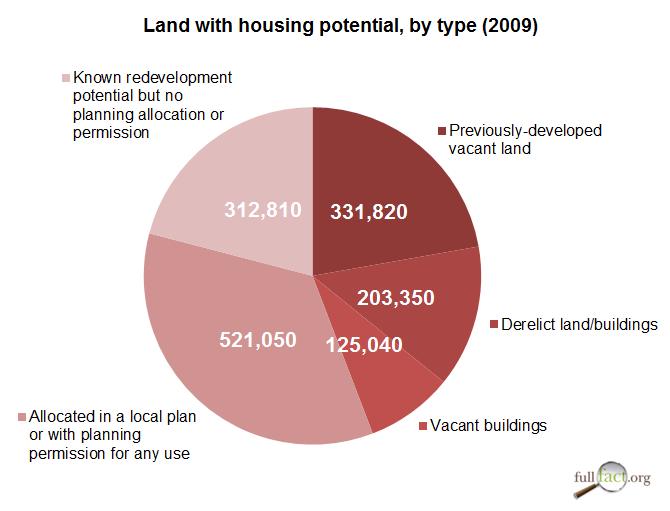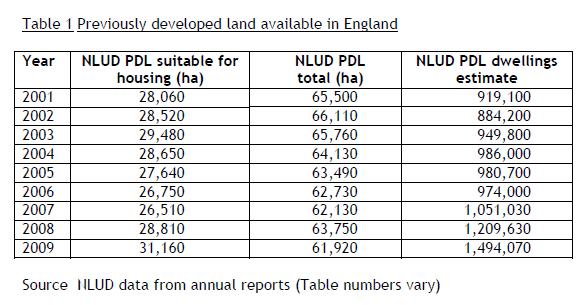Is there enough brownfield land for 1.5 million new homes?
"Government figures show that the amount of brownfield land becoming available for re-development is far outstripping the rate at which it is being used and there is enough available for 1.5 million new homes."
Campaign to Protect Rural England, Independent, 3 September 2012
Growing concerns that the Government may be paving the way to build more homes on the nation's Green Belt land in order to boost the UK's flagging economy were clearly articulated in this morning's Independent.
Among the groups eager for the Coalition to keep its pledge to "maintain the Green Belt" were the Campaign to Protect Rural England (CPRE), who expressed concerns that relaxing planning laws to allow more Green Belt development wasn't necessary given the plentiful supplies of brownfield sites.
Join 72,953 people who trust us to check the facts
Sign up to get weekly updates on politics, immigration, health and more.
Subscribe to weekly email newsletters from Full Fact for updates on politics, immigration, health and more. Our fact checks are free to read but not to produce, so you will also get occasional emails about fundraising and other ways you can help. You can unsubscribe at any time. For more information about how we use your data see our Privacy Policy.
They claimed that there was enough brownfield land available for 1.5 million new homes. Can this be true?
Analysis
'Browfield land' is referred to in official statistics as 'Previously Developed Land (PDL)' and encompasses "land that was developed but is now vacant or derelict, or currently in use with known potential for redevelopment".
In other words, this generally excludes agricultural and forestry holdings, landfills, gardens, parks and allotments. Most of these fall under the Department for Communities and Local Government's (DCLG's) guidance on designating Green Belt land.
The relevant statistics on land use are compiled on the National Land Use database and published by the DCLG. The most recent figures for brownfield land is for 2009. After contacting the DCLG, they confirmed that there had been a delay in updating these figures, but we could expect 2010 figures later this month.
The figures that are available show that, overall, there were 61,920 hectares of brownfield land in 2009, roughly the equivalent of 100,000 small football pitches. This compares to England's Green Belt, which covers approximately 1,639,540 hectares.

Most of the brownfield sites (54 per cent) are made up of vacant or derelict buildings or land. The rest represent buildings currently in use with the 'potential for redevelopment'.
However, what we should be interested in is how much of this land has 'housing potential'. The DCLG makes exactly this calculation, finding from local planning authorities (who have the power to designate some of the land in their area) that 31,160 hectares of land is 'potentially suitable for housing' and:
"could potentially provide around 1,494,070 dwellings."
This calculation is based on estimating the average number of houses that can be built per hectare of land. The national average for this is 48 dwellings per hectare, although the regional variation is considerable. London has 126 dwellings per hectare while the North East has 33 per hectare.
A breakdown of these 1.5 million dwellings by type is shown in the chart below:

So can't we just start building here?
Unfortunately, it's not that simple. The DCLG notes immediately after providing the figures that:
"there are likely to be barriers to development for some of this housing capacity: not all of it can be expected to come into use in the immediate future."
The Department goes on to specify the kinds of challenges to building associated with each type of browfield site. 'Previously-developed vacant land' and 'vacant buildings' present relatively few barriers since they can be built upon or reoccupied without the need for 'treatment' (demolition, ground levelling, etc).
However, 'derelict land/buildings' pose more of a problem, since they can't be put to beneficial use without either demolition, clearing fixed structures or levelling. Those with 'known redevelopment potential' could have future potential but are for the time being in use. Land is placed in this category at the discretion of local authorities before they reach a planning permission stage.
This means, although we cannot be precise, around 203,000 of the 1.5 million potential sites face barriers before they can be made into homes. A further 312,000 are currently in use and don't have planning permission to change.
So while the CPRE are correct to say that England's brownfield land holds the potential for 1.5 million new homes, it's reasonable to assume that for a significant proportion of these it isn't immediately feasible to build until the obvious barriers have been overcome.
Is more land becoming available?
In November 2011 the CPRE released a report compiled by Green Balance which aimed, in part, to highlight a number of statistical misunderstandings in the debate over whether brownfield building targets are needed.
They point out that, while the total brownfield land area in England has been decreasing since 2001, the area suitable for housing has actually increased, and in 2009 stood at its highest recorded level.

The Communities and Local Government Committee's report on the National Planning Policy Framework (NPPF) in 2010 also commented:
"Even in the regions with lowest availability, it would take seven years of housebuilding on previously-developed land at pre-recession rates to use up the current supply... However, figures also show that the supply of previously-developed land is being replenished at almost exactly the rate it is being used in England as a whole, with some regional variation, so it should not be considered a finite resource."
Conclusion
It's unfortunate that the most up-to-date data on brownfield land and housing potential is for 2009, however we can expect more recent figures - for 2010 - later this month.
Using what we currently have available, the CPRE's claim is backed up by the Government's own figure for the amount of brownfield land with housing potential. This works out at 31,160 hectares - or 50,000 small football pitches. Enough, claim the Department, for up to 1.5 million new homes.
However, the 'solution' to the Government's dilemma isn't as simple as actually building these brownfield homes. Barriers stand in the way of developing several hundred thousand of these potential sites and so we can't fairly say the Government has the potential to build immediately this many homes on brownfield sites alone. It could seemingly, however, take steps towards realising this potential if it chooses to do so.
Update (4 September 2012)
It's worth pointing out that there isn't widespread agreement that building housing on brownfield land is necessarily a good thing. The Goverment presents some of the cases in an impact assessment for the NPPF:
"The target to build 60% of England's new homes on brownfield land was introduced in 1999. This centrally imposed target had negative outcomes, resulting in imbalances in housing provision for example between blocks of flats and family homes with gardens. The brownfield target was also seen to drive up land prices in certain areas and would increasingly limit the supply of new housing as stocks of brownfield land are used up, which would harm first time buyers."